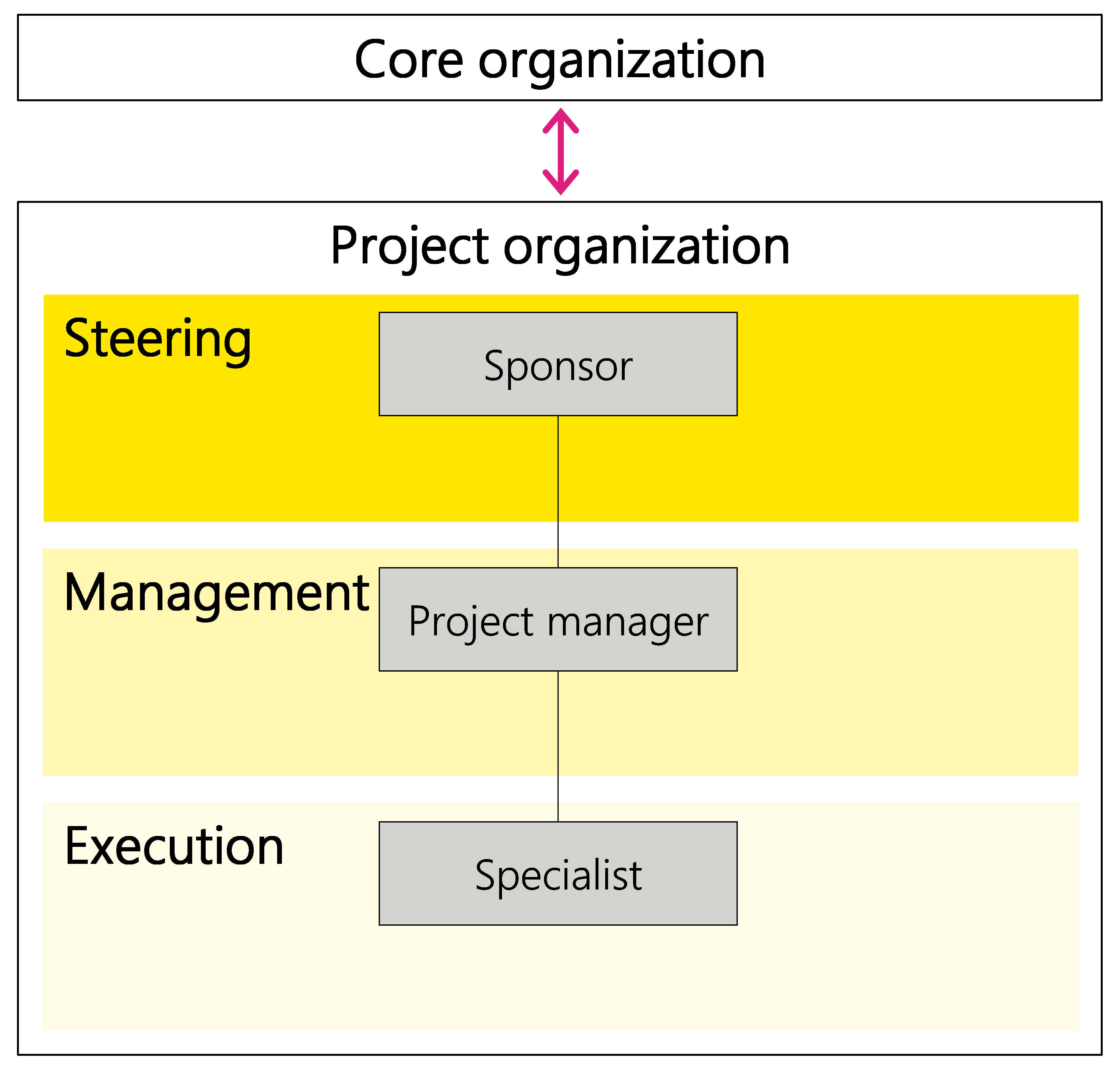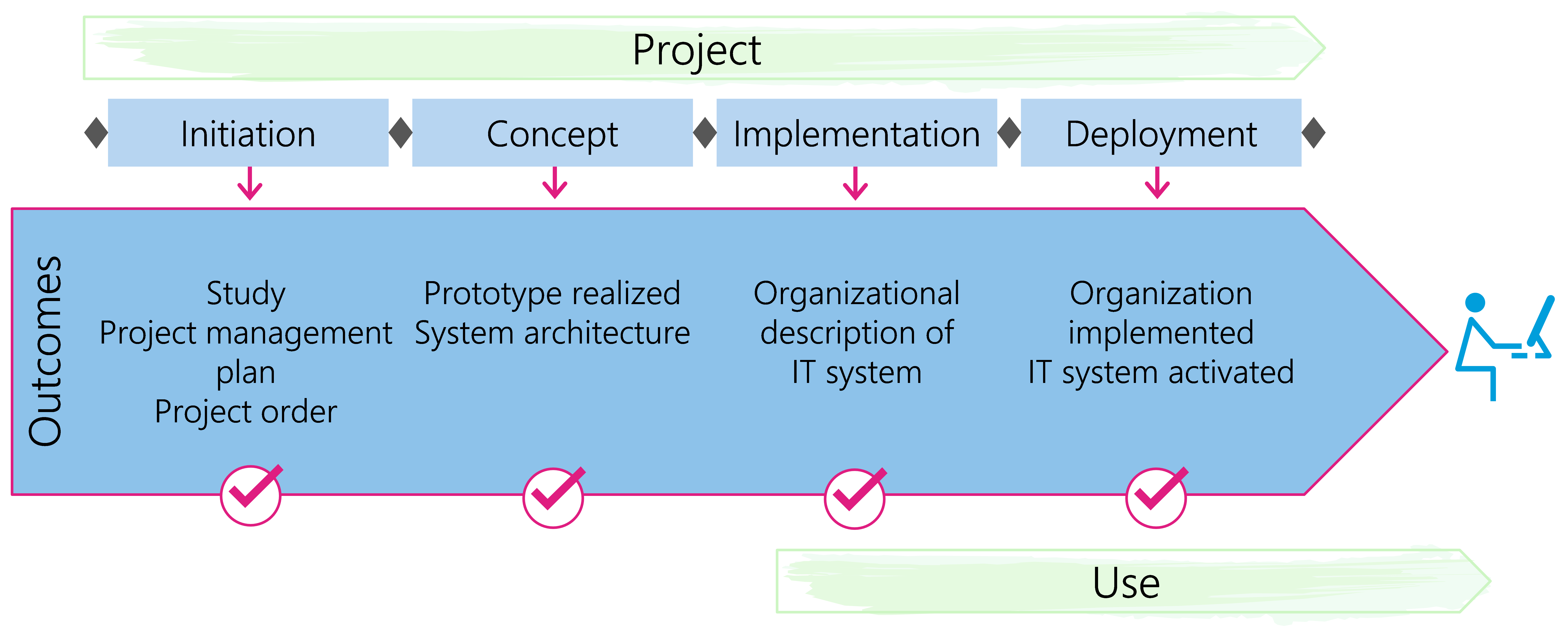Method overview
Definition of the HERMES method
HERMES is the project management method for projects in the area of IT, service and product development, and business organization adjustment. HERMES supports the steering, management and execution of projects with various levels of complexity and different features. As a method, HERMES has a clear, easy-to-understand structure, has a modular design and can be expanded. The main method components and how they interact are described below.
Scenarios
Various projects are carried out within an organization. Projects can vary considerably in terms of content and complexity. HERMES provides scenarios to satisfy the diversity of projects.
A scenario is oriented towards the implementation of projects of a specific nature. The scenario contains precisely those HERMES method components that are important for the project. Consequently, HERMES is quick and easy to use. Figure 1 shows a sample portfolio with the appropriate scenarios for the projects.

The project manager selects the appropriate scenario for his project. He plans the project on that basis. HERMES offers a range of standard scenarios, e.g. for the procurement and integration of a standard IT application, the development of IT infrastructure and the development of a service/product.
HERMES users can adapt standard scenarios to the needs of their organization and create further, individual scenarios. Individual scenarios can be officially made available to other HERMES users by being proposed to the eCH association for validation.
Phases and milestones
The phase model forms the backbone of the project, irrespective of the scenario. It creates the conditions for the project participants' common understanding of the course of the project. This is an important prerequisite for the successful cross-organizational handling of projects.
Projects are carried out in four phases according to a uniform phase model. The project starts with the initiation phase with the project initiation order milestone and ends with the end of the deployment phase with the project closure milestone. The phases start and finish with milestones. Tasks that lead to a decision also end with a milestone. Depending on the scenario, there are various milestones. Figure 2 shows the phases of a possible project with some milestones.

Milestones correspond to quality gates when the outcomes and the procedure are decided. This also involves coordination with the strategic objectives and specifications of the core organization.
Reporting is carried out periodically throughout the phases in accordance with the specifications of the core organization.
Modules
Modules are reusable building blocks for creating scenarios. A module contains the thematically related tasks, outcomes and roles (see Figure 3). They are assigned to phases and milestones.

For example, HERMES groups the project steering tasks and outcomes in the project steering module. This makes it easy for project sponsors to see the tasks and outcomes for which they are responsible.
HERMES users can create additional modules that they can integrate into their individual scenarios.
Roles
HERMES distinguishes between core organization roles and project organization roles, and defines how they are related. There is a role description for each project organization role. It defines the responsibility, powers and required skills for the role. Each project organization role is assigned to one of the hierarchy levels of steering, management or execution.
Partners in the project organization are users, creators and operators. Each role is assigned to one or more partners.
Figure 4 shows the minimum project

organization with the roles of project sponsor, project manager and specialist. Many other roles that can be used as required are defined in HERMES.
Tasks
Tasks are used to develop outcomes.
There is a task description for each task. It defines the general approach and the activities that are undertaken to produce the outcomes. Each task is assigned a responsible role. Thematically related tasks are grouped into modules and assigned to phases (see Figure 5).

Outcomes
As shown in Figure 6, outcomes are at the heart of HERMES.

For each outcome, there is a description of the outcome. For many outcomes, there are document templates that describe the content in the outcomes in more detail. Roles are assigned to each outcome. These give an indication of the involvement in the production of outcomes. Minimum outcomes are defined to meet project governance requirements. Thematically related outcomes are grouped into modules and assigned to tasks and phases.
User information
The user information describes specific aspects of HERMES. It forms the basis for a deeper understanding of methods, for example with regard to governance and sustainability. It also shows how HERMES should be used in specific situations and helps to reduce the scope for interpretation, for example in agile development or the application of HERMES in programs.
